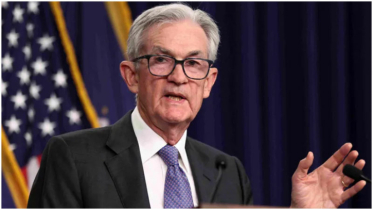Gold rises, oil slips after Iran attacks Israel

Gold prices jumped on Monday, attracting some safe haven bids, while oil prices were choppy after Iran's retaliatory drone and missile attack on Israel over the weekend stoked fears of a wider regional conflict and kept traders on edge for what comes next.
US stock futures ticked higher after major indexes ended sharply lower on Friday as results from major US banks failed to impress.
Iran had, late on Saturday, launched explosive drones and missiles at Israel in retaliation for a suspected Israeli attack on its consulate in Syria on April 1, marking its first direct attack on Israeli territory.
The threat of open warfare erupting between the arch Middle East foes and dragging in the United States has left the region on tenterhooks, as US President Joe Biden warned Israeli Prime Minister Benjamin Netanyahu the Biden Administration will not take part in a counter-offensive against Iran.
Israel said "the campaign is not over yet".
Global markets struggled for direction early in Asia on Monday after the weekend developments in the Middle East, as oil prices edged broadly lower in volatile trade, gold jumped and the dollar held broadly steady.
Brent crude futures LCOc1 eased 0.25 per cent to $90.21 per barrel, while US West Texas Intermediate CLc1 crude futures fell 0.35 per cent to $85.36 a barrel.
Gold XAU= rose 0.7 per cent to $2,359.92 an ounce, after having scaled a record of $2,431.29 on Friday. The yellow metal has climbed some 14 per cent for the year thus far.
"Everything seems pretty well contained," said Chris Weston, head of research at Pepperstone. "From a very simplistic perspective, the actions from Iran haven't really surprised anyone, they're very much in line with what we were pricing late last week.
"What may be causing a slight move up in the gold price... is the idea that we could see another counter response from Israel, and if that was to happen... that could cause risk (assets) to move down."
Elsewhere, US 10-year Treasury futures TNc1 edged slightly lower with an implied yield of 4.53%, while the dollar held near a 34-year high against the yen JPY=EBS at 153.27.
The euro EUR=EBS and sterling GBP=D3 were similarly pinned near five-month lows.
A continued run of resilient US economic data, particularly last week's hotter-than-expected inflation report, has prompted investors to reset their expectations of the pace and scale of rate cuts from the Federal Reserve this year as inflation proves stickier than previously thought.
Futures now point to about 50 basis points worth of easing expected this year, a huge pull back from the 160 bps that was priced in at the start of the year.
That sea change in the rate outlook has in turn sent the dollar on a tear and US Treasury yields surging, with the two-year yield US2YT=RR rising above 5% for the first time since November last week.
"We have updated our forecasts for the US FOMC, pushing out the timing of the start of the interest rate cutting cycle to September 2024, from July previously," said Kristina Clifton, a senior economist at Commonwealth Bank of Australia.
"The US CPI has been stronger than expected over the first three months of 2024. We expect that it will take a string of inflation prints of 0.2%/month or lower to give the Fed confidence that inflation can stay sustainably lower and that interest rates do not need to remain at a restrictive level."
A slew of Fed policymakers are due to speak this week, including Chair Jerome Powell, who could give further clarity on the future path of US interest rates.
In stock markets, S&P 500 futures ESc1 and Nasdaq futures NQc1 each rose 0.3 per cent in early Asia trade, reversing some of the heavy losses in US equities on Friday.
All three major indexes had registered losses on the week, weighed down by lacklustre bank earnings and the evolving expectations for Fed policy.
"At the end of the day, what we're seeing at the moment is the market is really trying to understand what's going on. Their visibility to price risk in this market has become a bit more troublesome, and I think when you don't have that visibility, you do get higher volatility. That's kind of where we are," said Pepperstone's Weston.
Bitcoin BTC= was last more than 2 per cent lower at $65,547, after falling below $62,000 on Sunday. The world's largest cryptocurrency scaled a record high last month thanks to flows into new spot bitcoin exchange-traded funds and expectations of imminent Fed rate cuts.
.png)




